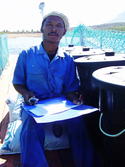
The growth rate of the fish in freshwater farming systems (aquaculture) has to be monitored throughout the season. Any change in the expected growth rate could indicate feeding problems, poor water quality or diseases.
Disturbances caused by humans or animals can also cause stress and lead to slow growth, explains Henk Stander principal technical manager of Aquaculture: Department of Animal Sciences, Stellenbosch University. Growth rate can be measured by test sampling.
Test sampling is the removal of fish from the dam (or tank) to assess their growth and health status. After the observations fish are returned to the water. Test sampling to determine growth rate is also the ideal opportunity to evaluate the overall condition of the fish. You will be able to check for wounds, spots, colour changes, cut fins or blindness.
Do not overreact. First, determine the extent of abnormalities and then contact supporting technical staff to assist. Report any of these conditions to ensure prompt reaction. The procedure to conduct a random test to measure growth tempo is indicated below.
What is Required to Measure Growth Rate?
Writing pad Scale (0 - 100 kg) Black rubbish bins (50 - 80 litres) Safety fish nets to prevent escapes Scoop net The assistance of at least two helpersHow to Measure Growth Rate?
Starve fish (do not feed) for 24 hours before the sampling. Sample one cage at a time. Drive fish together by gradually making the net cage shallower to a depth of 1 - 2 m. Then, split the cage by pulling a rope across under the cage so that most of the fish are trapped on the side where the sampling will be conducted. Do not throw feed to attract fish.
This will present inaccurate data as only the biggest and strongest fish will reach the feed first. Place the scale and drum on a safety net to prevent fish that jump out of net or drum falling into the dam. Fill the drum with water and place on the scale. Zero the scale. Scoop fish into the drum at weights of 10 kg for fish weighing 150 - 500 g each and 20 kg for fish weighing 500 - 1000 g.
Record the weight of the fish in a table. Release fish into the cage/tank by slowly counting the fish. Let both persons who handle the drum, do the counting and confirm afterwards. If numbers do not correlate, ignore the sample and repeat. It is very important to record the weight of fish accurately and do the counting correctly to obtain a reliable average weight.
Repeat the sampling procedure with other cages/tanks until approximately 5 percent of the fish population number has been sampled. Always treat fish very carefully and gently. Fish are stressed every second they are out of the water. Complete the sampling as quickly as possible and lower the nets to the original depth so that the fish can swim freely in cages.
Calculation of Average Fish Weight and Total Biomass
The total biomass is the total weight of all the fish in a cage or tank. Calculate an average weight for the cage of fish by doing the following: Add up the weights of all the samples to get a total weight. Then, divide the total weight by the total number of fish counted.
According to the table above, the average weight of a fish is 483 g = 50.73 kg ÷ 105. (50.73 kg = 50 730 g). Calculate total biomass by multiplying the average weight of a fish with the number of fish in the cage. Example: 483 g x 3 390 fish in cage = 1 637 kg (0,483 kg x 3 390 = 1 637 kg).
Calculate the Feed Conversion Ratio
The ‘feed conversion ratio’ (FCR) is the number of units of feed an animal uses to produce one unit of product e.g. the kg of feed used to produce 1 kg of meat. FCR is an important measure for judging the economic performance of an animal. To calculate the FCR will help a fish farmer judge his feeding program and see how his fish are gaining weight.
Evaluate feed conversion ratios on a monthly basis.
Calculate the FCR by dividing the weight gain of fish biomass since the last sample by the feed consumption for that period. For example, if the last weight sampling was on 31 March and the recent weight sampling is on 30 April, the feeding period was 29 days and 350 kg feed was used.
Weight gain:
Biomass at 31 March was 1 330 kg and on 30 April it was 1 637 kg, thus weight gain was 307 kg (1 637 kg - 1 330 kg = 307 kg) See the table above.
FCR:
To calculate the FCR, divided the weight of feed by the weight gain.
350 kg feed ÷ 307 kg of fish = 1,14
It means that 1,14 kg feed was required to produce 1 kg of fish weight.
Thus the FCR is 1:1,14
The FCR can vary and depends on the fish species, kind of feed, water quality and natural food availability. Also, FCR is much better for younger fish than for larger fish of the same species in the same environment.
Remember: the lower the FCR, the better the feed is being utilized by your fish.
For example, an FCR of 1:1,2 is good and an FCR of 1:2,5 is poor.
Compare results with the suggested growth curve according to the feeding programme. Investigate and adapt management if the actual growth is more than 5% lower than the expected growth rate.
By Marinda Louw